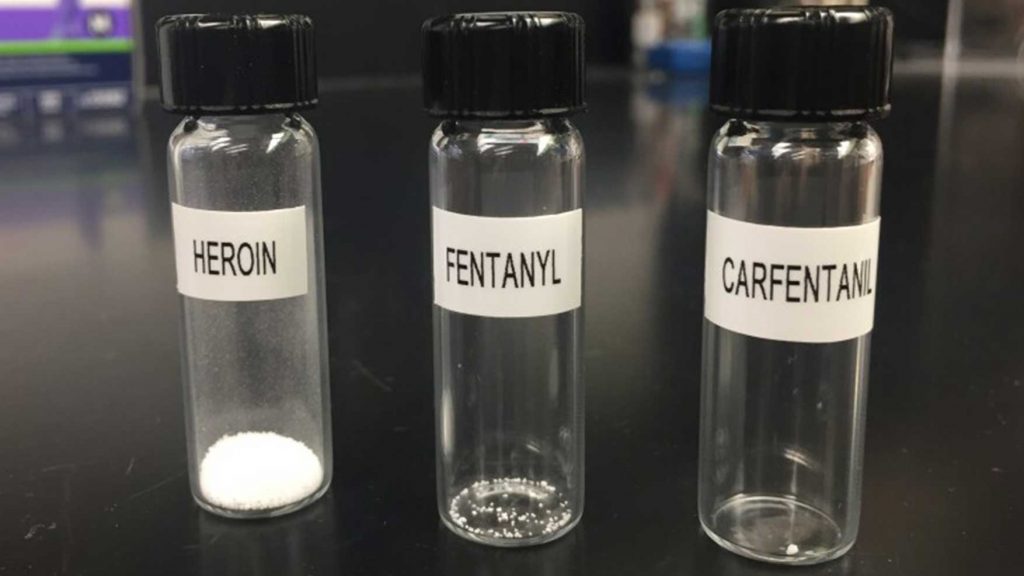According to the National Institute on Drug Abuse, most overdose deaths involved synthetic opioids, which are analgesics (painkillers) made in laboratories. They act similarly to opiates (natural opioids) such as morphine and codeine. However, they’re much more powerful.
Two of the most well-known and deadly synthetic opioids are carfentanil and fentanyl.
Carfentanil Vs. Fentanyl
The United States Drug Enforcement Administration (DEA) classifies both carfentanil and fentanyl as Schedule II Controlled Substances. That means that although they have legitimate medical uses, they pose a high risk of abuse and addiction.
Despite their similarities, the drugs differ in a few key ways.
What Is Carfentanil?
Carfentanil is a fentanyl analog. That means it was created to mimic the effects of fentanyl. However, it’s about 100 times more powerful.
Sold under the brand name Wildnil, carfentanil is not intended for human ingestion. Instead, veterinarians use it as a tranquilizer for elephants and other large mammals.
In recent years, some people have started selling carfentanil on the street, often disguising it as heroin. It’s sold in many forms, including:
- tablets
- powder
- blotter paper
- spray
Some forms of carfentanil can be accidentally inhaled or absorbed through the skin. Thus, law enforcement officials, first responders, and other professionals must take extreme caution when interacting with the drug.
Carfentanil Overdose
Because it’s so powerful, even a small amount of carfentanil can cause a fatal overdose. Common signs of overdose include:
- confusion
- dizziness
- nausea and vomiting
- severe drowsiness
- respiratory depression (slow, shallow breathing)
- slow heartbeat
- trouble swallowing
- pale, clammy skin
- bluish lips and/or fingernails
- smaller pupils (also called “pinpoint pupils”)
- loss of consciousness
If you or someone you know experiences these symptoms, call 911 right away.
In most cases, first responders will treat a carfentanil overdose by administering naloxone (brand name Narcan).
This medication attaches to opioid receptors in your brain and rapidly reverses the effects of an opioid overdose. Since carfentanil is so strong, the person who overdosed may need multiple doses of naloxone.
What Is Fentanyl?
Fentanyl is a prescription opioid used to treat severe pain, including cancer pain, chronic pain, and post-surgery pain. It’s prescribed in various forms, including:
- tablets (sold under the brand name Abstral)
- lozenges (Actiq)
- patches (Duragesic)
- injections (Sublimaze)
Fentanyl Abuse & Overdose
All forms of fentanyl can cause side effects like drowsiness, nausea, and constipation. Some people abuse prescription fentanyl by using it in a manner not prescribed by a doctor. For example, they might:
- take it more frequently than prescribed
- take higher doses than prescribed
- mix it with other drugs
These behaviors pose a high risk of overdose. However, most people who overdose on fentanyl don’t use prescription fentanyl. Instead, they use fentanyl that was made illegally and sold on the street. Street fentanyl usually resembles a white or brown powder, clear liquid, or white pill.
Fentanyl & Other Substances
Some drug dealers mix fentanyl powder with other substances, including heroin, meth, and cocaine.
Others make fentanyl pills and pass them off as other drugs, such as Xanax or ecstasy. They do this to give buyers a more intense high or to cut production costs (as fentanyl is very cheap). In many cases, buyers don’t know when a drug contains fentanyl.
Treatment For Carfentanil & Fentanyl Addiction
Most people with opioid addictions need professional treatment. When you enter an opioid treatment program, doctors will design a personalized treatment plan for you. The plan may include services such as:
- medical detox, where doctors will help you slowly and safely stop using opioids
- mental health counseling, where a therapist will help you identify and manage triggers (people, places, or other stimuli that make you want to use opioids)
- medication-assisted treatment, where doctors will prescribe medications like methadone and buprenorphine to ease opioid cravings and withdrawal symptoms
- support groups, where you can share coping strategies with other people recovering from opioid addiction
To learn more about opioid addiction treatment options, please contact Northeast Addictions Treatment Center. We offer personalized, evidence-based care to help you stay healthy and drug-free.
Sources:
National Institute on Drug Abuse — Fentanyl DrugFacts
United States Drug Enforcement Administration — DEA Issues Carfentanil Warning To Police And Public
United States Drug Enforcement Administration — Drug Scheduling
United States National Library of Medicine — Fentanyl


